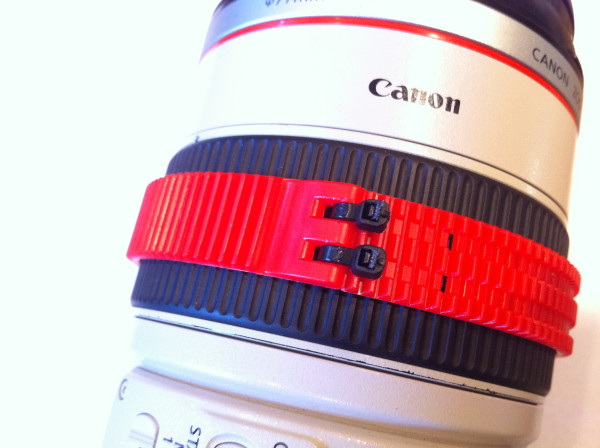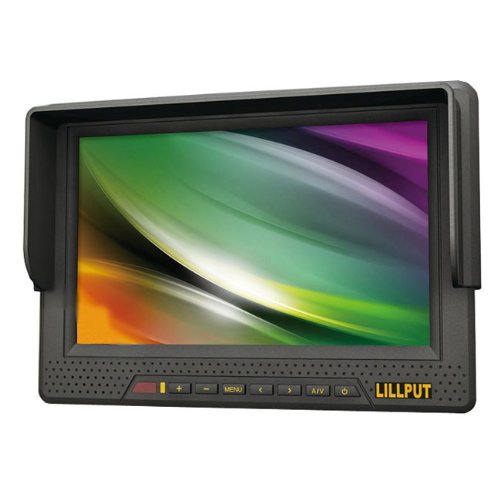As you may have gathered from Ashley's recent post about art department lifesavers we have been doing some filming lately. After several days on set, I've come to deeply appreciate some small, even seemingly minor, accessories and pieces of camera-related equipment -- "kit" in industry parlance. I thought I'd discuss a few of these items, each of which is under $200. We're using a Sony FS100, a Red Rock Micro follow focus and low-rise baseplate, an assortment of Nikon lenses, and a Heliopan variable ND filter, but many of the items listed below would be at home on a DSLR-based shoot or a shoot with a more traditional video camera (Sony EX1, Panasonic HVX200, etc).
Zip tie lens gears. Lenses that were designed for stills, not cinema, lack a gear that allows them to be used with a follow focus. One solution would have been to use the gear rings that we had from Red Rock Micro. These are functional, but they have a number of disadvantages: they're large, they can be time consuming to put on/take off, and at $40 each, they're overpriced. Zip tie lens gears are inexpensive and easy-to-add to every lens you own. Once on your lens, you can forget about them. $40 for 3.

Wet Erase Markers
Filter pouch. Our Heliopan Variable ND filter comes in a less-than-ideal case. It's a very tight fit, to the point of seeming like it could scratch or scuff the glass. We quickly bought a filter pouch to protect our investment. $9.
77mm step up rings and lens caps. We use a 77mm variable ND filter on set, which at that size has the ability to cover all of our lenses when using step-up rings. After a few days of filming with one step-up ring per size needed (e.g., a 52-to-77, a 62-to-77, etc.) we found that we were being slowed down by having to unscrew the step-up rings from lens to lens, particularly when so many of our most-used lenses (e.g., 28, 35, 50) all had a 52mm threading. So we splurged and purchased the necessary step up rings for all of our lenses. Now all of our lenses have a 77mm "face" (and accompanying lens cap). Though step up rings seem like an inexpensive piece of kit, read the reviews and buy a reputable brand like B+W, Heliopan, etc. Lesser step up rings can seize up, making that expensive variable ND filter a big headache! Step-up rings: $25 - $45. Lens caps: $5.

Lens cleaning tools.
We switch lenses and filters often, which means more chance of dirtying them. We keep our glass clean with:
Nikon Lens Pen


Lilliput 7" 668GL On-camera HD Monitor In 2010 I read about Lilliput's small, inexpensive HD monitors. At the time, they only seemed to be sold on Ebay. I bought one off almost as a novelty, not expecting much from it since it was so much cheaper than other HD monitors on the market. While its picture is not as vivid or high resolution as that of other portable HD monitors I've used, it works, it's lightweight, and it's far more affordable. The one I bought over a year ago didn't have a battery pack like the new ones they make, so I had to buy an Ikan battery AC/DC adapter plate, which allows me to use Sony batteries with it. The new models, which you can purchase through Amazon, now come with their own battery solution and component inputs. As for its application, I tend not to use it if I'm operating camera myself, but when working with a DP or camera operator I use it as my "director's monitor." It's especially useful when filming in tight spaces (like a car -- see below) where using your camera's LCD monitor or viewfinder isn't an option. $170.
HDMI Cables It's nice to have different lengths of HDMI cables to use with the Lilliput monitor. I've used these Insignia brand cables on set for a few weeks and haven't had any problems. One's a 9 footer, one's a 3 footer. $10.
FilmTools Gripper 116 XL car mount. Trying to shoot smooth car footage handheld , particularly with a CMOS sensor prone to "jell-o", can be a test of one's patience. This FilmTools car mount affixes to your car's windows or windshield with a large suction cup and will support cameras up to 9 pounds. $110.
Coleman LED Quad Lantern

Two-Way Radios
Canare breakaway cable For the uninitiated, a breakaway cable consolidates multiple XLR and mini cables into one neat cable, which can be run from a location audio mixer to a camera (or audio recorder). Though it may seem overpriced for what is seemingly a bunch of XLR and mini plug cables wrapped together, if you're using a mixer and feeding that audio into your camera the simplicity, organization, and mobility that a breakaway cable provides is well worth the cost. In addition to feeding your camera two tracks of audio with one cable, a good breakaway cable also give the sound mixer a means to listen to the "return" audio instead of the audio from the sound mixer. This is the best way to monitor the audio being mixed, so for me it's worth the investment. $190.

 In 2010 I
In 2010 I